DISCLOSURE: This post may contain affiliate links, meaning when you click the links and make a purchase, I receive a commission. As an Amazon Associate I earn from qualifying purchases.
If I was stranded on an island surrounded by freshwater and I could only request one thing, it would be a fishing rod rigged with a chartreuse jig. Its lightweight, durable, versatile, and consistent nature make jigging for crappie the go-to technique for many crappie fishermen.
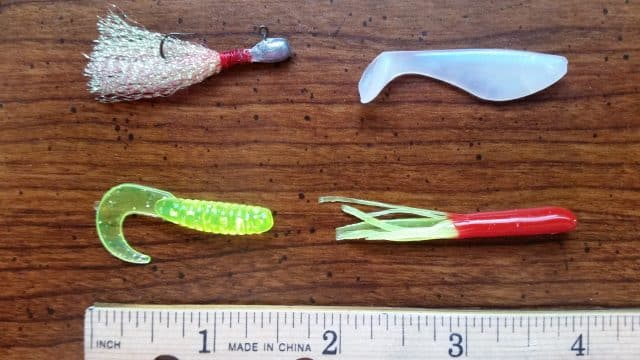
Jig Types
There are four main types of jigs used when jigging for crappie:
- Curly tail
- Tail wiggles as it’s pulled through the water
- Plastic skirt
- More subtle than the curly tail
- Marabou (hairy)
- “Breathes” when moved subtly
- Fish-shaped
- Can closely mimic local forage
When used together with the right jig head, this is often all you need to start catching fish. Take a look at the 8 Best Crappie Lures, Jigs, and Bait for a couple good jig choices available on Amazon.

Jig Heads
The purpose of a jig head is to add weight to a jig, give at an “eye” to make it look more lifelike, and obviously provide a hook. They are usually made out of lead or tungsten to provide a good amount of weight in a small package. 1/32 to 1/8 oz jig heads are most often used when jigging for crappie. Ice fishing for crappie generally calls for lighter jigs due to crappie’s slower winter metabolism and their inability to chase a fast falling jig. On the opposite end of the spectrum, you can try going larger than 1/8 oz in the winter and early spring when baitfish are larger. As far as lengths, you can eliminate anything over 2 inches. These are just too big for the majority of crappie.
Jig heads come in many shapes but the most common to use when jigging for crappie is the ball style. This type of jig head essentially provides uniform movement in all directions. This website has a great description of other shapes of jig heads and the purposes of each.
Jig and Jig Head Colors
There are quite a few differing opinions out there on which jig color to use when. What I’ve learned is that chartreuse is always a good choice. Beyond that, it’s up to experimenting and seeing what works. You can read into the details on choosing jig colors for crappie here.
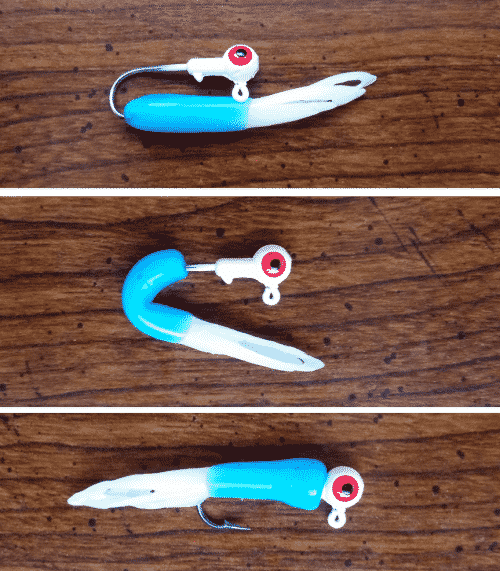
Hooking a Jig onto a Jig Head
When putting a jig onto a jig head, start by pushing the hook through the top of the jig. Keep pushing the hook through the center of the jig body until the top of the jig meets the bottom of the jig head. At that point, poke the hook out of the jig. The overall goal is to have the jig head in line with the jig body and the hook centered through the jig body.
Tying the Knot
There are two main types of fishing knots that I think are important to know. The clinch knot and the loop knot. I’ve been using the clinch knot for tying on lures and hooks since I was kid. It’s easy to tie and I’ve only ever had a couple times where it broke. If you want to improve on this simple knot go with the Trilene (aka double clinch) knot. This knot adds one more step in the tying process to improve its strength.
If you are using really small jigs (1/32 oz) or you just want the unrestricted movement that a barrel swivel gives, try the loop knot. This knot will allow your jig to have more action than any clinch knot would.
Check out our picks for the best fishing knots and more details on how to tie them.
If you feel like you are getting lots of bites but unable to hook the fish, the problem maybe your knot placement.
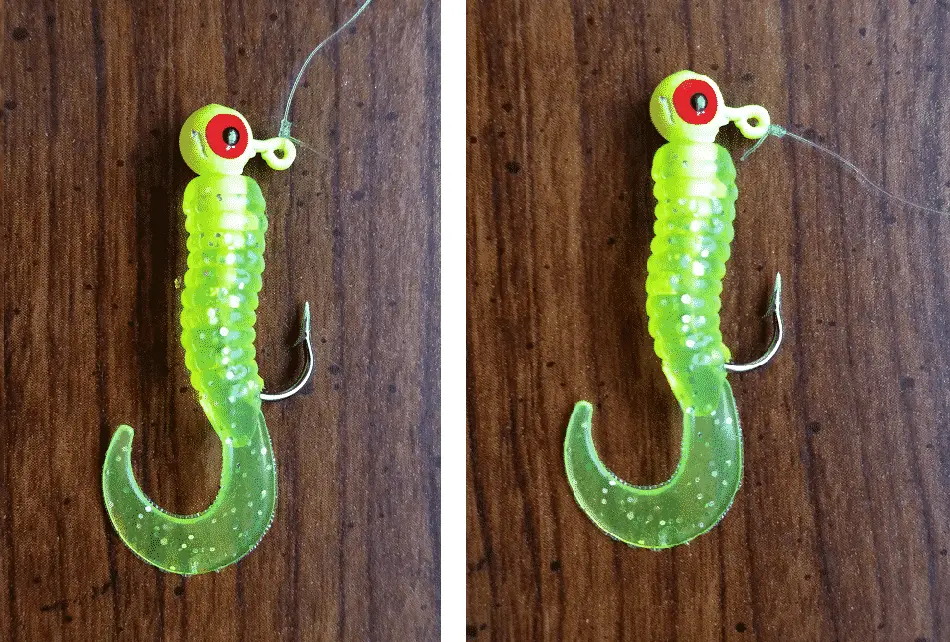
It’s important to place your knot on the jig head such that when you let the jig hang, it stays horizontal. If the jig hangs at an odd angle, it will be less appealing to crappie and you will miss more strikes. If you have the knot placement correct, you can try widening the bend in the hook slightly.
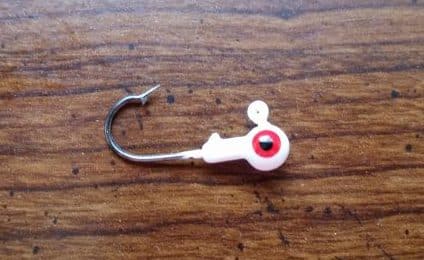
This is an old trick that can improve your hooking rate when jigging for crappie. The reason it works is because the hook points slightly up, allowing it to catch on the roof of a crappie’s mouth more easily.
If you are wondering which fishing line to use, check out this article on choosing the best fishing line for crappie.
Vertical Jigging Rig 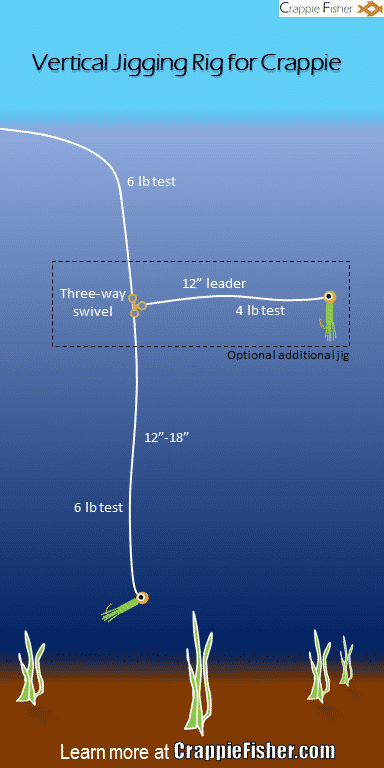
Vertically jigging for crappie is probably the most common technique used with jigs. It’s an extremely simple yet extremely effective setup. Essentially all this rig consists of is a jig tied on to the end of your line. Optionally, you can add an additional leader with another jig tied 12”-18” up from the first jig to cover more water and increase your chances.
To use this rig, first cast or drop the jig down into an area you believe might be holding crappie. Many times the crappie will strike when the jig is sinking, so be patient. After letting the jig sink to the bottom, subtly twitch the end of your rod. Let it sit for a few seconds. Then, reel it in about a foot. Repeat this process until you’ve reeled all the way in.
Another technique you can try is very slow, constant reeling. Keep reeling the line in at a slow pace and every so often twitch the rod tip.
Finally, a third technique you can try is yo-yo’ing while you retrieve. Essentially you pull the rod up a couple feet, let the rod back down, and then reel in a couple feet. Remember to keep it slow though to allow the crappie to chase the jig.
These techniques are a good place to start. You can try any combination of these techniques or even invent if your own if you find something else that works. Just remember to be subtle, slow, and patient.
Stump-Bumping Rig 
The stump-bumping rig is great to use around stumps and other solid structures. It uses the vibrations created by bouncing a weight off the structure to attract nearby crappie. You can use the same technique as with the vertical jigging rig, but make sure to keep your rig right on the structure you are fishing.
 Spider Rig
Spider Rig
Spider rigging is a great way to cover lots of water to find where and what depth the crappie are at. You will also find out very quickly what jigs are working. This technique consists of multiple rods being fanned out over the front or back of the boat. How many rods you use is really up to your skill level. Start out with two. If you can easily manage that, add another. Remember to check your local regulations to see if it’s legal to fish with multiple rods/hooks.
Ultimately, you can use this technique to eliminate unknowns when jigging for crappie. For example, if you know what color jig the crappie are liking that day but don’t know the depth, try different depths with each rod. If you have a good idea of the depth but have no idea what color they are biting, try different colors on each rod. If you have no idea where to begin at all, try different depths, colors, and jig types on each rod until you find something that works.
You can use any rig with this technique, including the vertical jigging rig or stump-bumping rig. You can even use spinners, crankbaits, or minnows. Let out about 50-75 feet of line. Start out by trolling 1.5-2 mph. Troll along the edge of weed beds, over holes or underwater rock piles. Once you start catching a couple crappie, maintain your location and setup your other rods in the same fashion as the ones you caught the crappie on.
A couple key points:
- Make sure you don’t get your lines caught in the motor prop
- Take the wind direction into account when trolling. You may have to slow down when trolling with the wind and speed up when going against it
- Utilizing boat rod holders like these will make this technique A LOT easier:
Other Jig Rigs
There are endless other ways to fish jigs. Some examples:
- You can utilize a bobber (like with this bobber-minnow rig) to maintain a certain depth and keep your jig from sinking too low
- You can use a flasher if the water is murky to visually attract nearby fish
- You can tip your jig with a piece of minnow flesh to add scent
Conclusion
Jigging for crappie is an essential skill for any crappie fisher. 1/32 oz to 1/8 oz jig heads paired with a curly tail or marabou jig is a great place to start. Make sure to tie a good knot and place it on the jig head in the right spot for maximum effectiveness. A simple vertical jigging rig or stump-bumping rig is a common and effective way to start catching crappie. If you are fishing a lot of water, try the spider rigging technique to find out what works. Learn these techniques well, get better at jigging for crappie, and become a better crappie fisherman.
